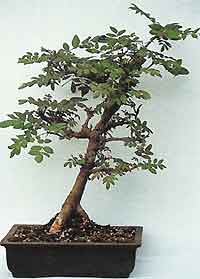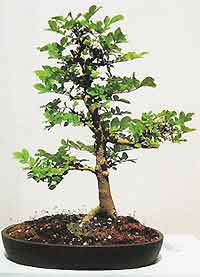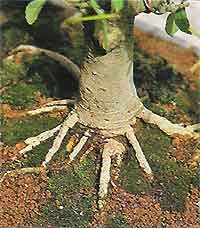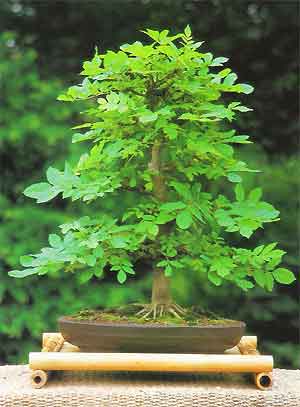Bonsai Trees
Case Histories
Common Ash - (fraxinus excelsior)
Ash Bonsai Style: Informal Upright

Driving to visit a friend one spring afternoon many years ago, a small tree growing on an old wall caught my eye. It was living outside a house and right next to the road. I had very few bonsai at that time and was eager to increase my collection, but being in a hurry, I planned to have a closer look on my journey back. When I returned the owner was in her front garden pruning roses. The tree was a naturally stunted ash, that must have struggled to survive for many years.
It was very dirty and grimy from passing traffic, but had an interesting shape and potential. I politely explained my interest to the owner and asked if I could rescue the tree from certain eventual death. She said that she had no interest in the tree and was somewhat bemused when I said that it would be going to a good home! I carefully pulled the ash from its small pocket of soil and crumbling mortar, thanked the owner and set off for home.
Ash Bonsai History: Training

The trunk of the ash was thoroughly washed and scrubbed, revealing a very interesting texture to the bark. I expected it to be smooth, but a large area was pitted giving the tree an aged look. The compact root system enabled it to be potted into a large bonsai pot . I angled the trunk heavily so that it could be trained in the slanting style. At that time it was the largest tree in my collection, and without doubt the most impressive as far as I was concerned, although I was quite aware that ash is not one of the most suitable species for bonsai cultivation.
Three years passed and the tree had grown well during that time. I leaf pruned it annually and the leaves were reducing in size. Every year in early spring the apical buds were removed, prompting the smaller buds to grow and resulting in more compact leaves. As my knowledge increased I realised that the surface roots were a very poor example for a bonsai tree. They resembled a pair of legs rather than convincing roots on an old tree! I turned the tree around and decided that a more suitable front would actually be the current back of the tree. At this angle the roots appeared less ugly. The trunk was positioned at a more gentle angle and the pot was changed for a shallower slate blue oval. These changes were definite improvements.

Five years later and I realised that I was never going to be happy with the root structure of this tree. The roots were an eyesore and had to be improved if this tree was ever going to become a reasonable bonsai Late that spring I removed a large ring of bark directly above the roots and painted this with hormone rooting liquid. The whole tree was then planted in a large flower pot and buried up to the first branch. It was now potted vertically which seemed to suit the tree more - I had only previously planted it in the slanting style because it made the large, ugly roots appear to be supporting the angle. That year the ash grew slowly and the soil was never allowed to become dry. Everything appeared to be going well with the tree and I was eager the see if new roots were forming, but decided to wait until early spring to see what was happening under the soil!
Spring arrived and I had repotted many trees - it was time to examine the ash roots. I removed the tree from its flower pot and I was pleased to discover that it was completely pot bound. The soil was carefully brushed away to reveal an excellent arrangement of surface roots. They were very established and well spaced around the trunk base, looking natural. The exercise had been a resounding success, transforming the tree's worst feature into its best. The ash was then planted upright in a small oval bonsai pot and angled completely upright. A large branch on the right was also pruned back to a younger shoot that was more in scale with the rest of the tree. It had started to take on a completely new appearance.

 Driving to visit a friend one spring afternoon many years ago, a small tree growing on an old wall caught my eye. It was living outside a house and right next to the road. I had very few bonsai at that time and was eager to increase my collection, but being in a hurry, I planned to have a closer look on my journey back. When I returned the owner was in her front garden pruning roses. The tree was a naturally stunted ash, that must have struggled to survive for many years.
Driving to visit a friend one spring afternoon many years ago, a small tree growing on an old wall caught my eye. It was living outside a house and right next to the road. I had very few bonsai at that time and was eager to increase my collection, but being in a hurry, I planned to have a closer look on my journey back. When I returned the owner was in her front garden pruning roses. The tree was a naturally stunted ash, that must have struggled to survive for many years. The trunk of the ash was thoroughly washed and scrubbed, revealing a very interesting texture to the bark. I expected it to be smooth, but a large area was pitted giving the tree an aged look. The compact root system enabled it to be potted into a large bonsai pot . I angled the trunk heavily so that it could be trained in the slanting style. At that time it was the largest tree in my collection, and without doubt the most impressive as far as I was concerned, although I was quite aware that ash is not one of the most suitable species for bonsai cultivation.
The trunk of the ash was thoroughly washed and scrubbed, revealing a very interesting texture to the bark. I expected it to be smooth, but a large area was pitted giving the tree an aged look. The compact root system enabled it to be potted into a large bonsai pot . I angled the trunk heavily so that it could be trained in the slanting style. At that time it was the largest tree in my collection, and without doubt the most impressive as far as I was concerned, although I was quite aware that ash is not one of the most suitable species for bonsai cultivation. Five years later and I realised that I was never going to be happy with the root structure of this tree. The roots were an eyesore and had to be improved if this tree was ever going to become a reasonable bonsai Late that spring I removed a large ring of bark directly above the roots and painted this with hormone rooting liquid. The whole tree was then planted in a large flower pot and buried up to the first branch. It was now potted vertically which seemed to suit the tree more - I had only previously planted it in the slanting style because it made the large, ugly roots appear to be supporting the angle. That year the ash grew slowly and the soil was never allowed to become dry. Everything appeared to be going well with the tree and I was eager the see if new roots were forming, but decided to wait until early spring to see what was happening under the soil!
Five years later and I realised that I was never going to be happy with the root structure of this tree. The roots were an eyesore and had to be improved if this tree was ever going to become a reasonable bonsai Late that spring I removed a large ring of bark directly above the roots and painted this with hormone rooting liquid. The whole tree was then planted in a large flower pot and buried up to the first branch. It was now potted vertically which seemed to suit the tree more - I had only previously planted it in the slanting style because it made the large, ugly roots appear to be supporting the angle. That year the ash grew slowly and the soil was never allowed to become dry. Everything appeared to be going well with the tree and I was eager the see if new roots were forming, but decided to wait until early spring to see what was happening under the soil!